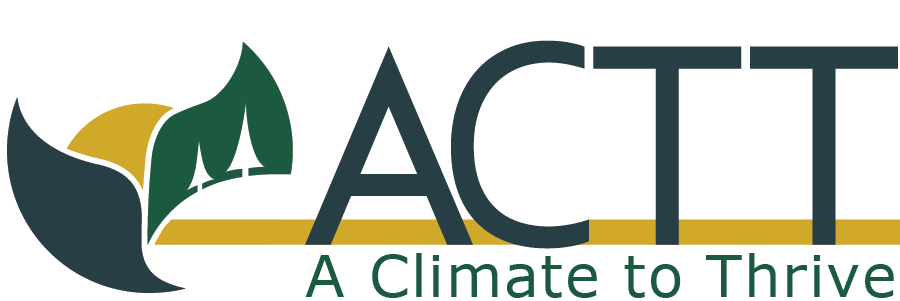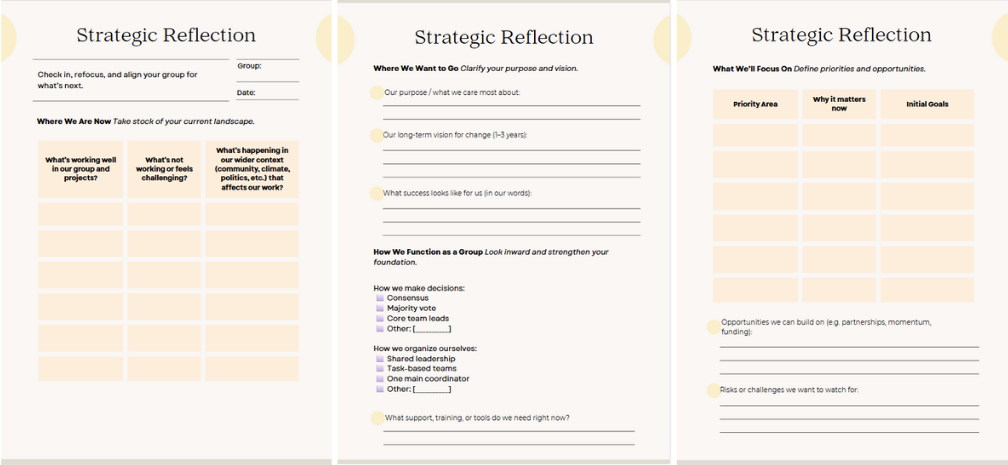Capacity Through Planning
While some initial planning occurs while an organization is first forming, there comes a point after initial meetings when it is ideal to develop a more robust plan. If your initiative is beginning by focusing on a specific project, this would be a strategic plan for that project. If your initiative is starting by focusing on several projects, the plan would encompass and tie together the full scope of your early work.
It is difficult to set a firm plan that covers much more than a year or two into the future. In developing your first strategic plan, focus on filling in the necessary details for the near-term and identify key questions that you will want to return to in order to paint a more detailed picture of the longer-term and a date in the future when it might be appropriate to begin to consider those questions. In doing so, you are walking the balance of planning while not forcing plans to exist where the background knowledge is not yet there to support that plan. You are identifying questions you will need to answer to inform future planning, information that needs to be gathered, and setting a rough timeline for gathering that information and returning to those questions. In short, you are walking an important balance between being strategic and being able to respond in an emergent manner.
Developing a Strategic Plan
1
3
Visibility & Engagement
Break down your mission and vision into specific, actionable goals. These should be measurable (e.g., reduce carbon emissions by 10% within five years, engage 500 community members in sustainability programs). If you are strategic planning for a specific project, these measurable goals will all be aligned with that project. If you are strategic planning more broadly, you will have goals tied to specific projects and goals tied to building the operations and sustainability of your initiative as well.
A great framework for setting clear goals is the SMART Goals method. SMART goals help provide clarity and direction, making it easier to measure your progress. You can find free SMART goal templates and worksheets here. This framework ensures that your goals are:
Specific: Clearly define the goal.
Measurable: Track progress with clear indicators.
Achievable: Make sure the goal is realistic.
Relevant: Align with your overall mission.
Time-bound: Set a deadline for achieving the goal.
SMART goals also lend well to grant requests and project progress tracking.
2
Identify Key Strategies
Timeline and Milestones
Develop a realistic timeline for reaching your goals and set milestones along the way to track progress. This ensures that your team remains focused and motivated, and it allows you to make adjustments as necessary.
Define Roles and Responsibilities
Create Decision-Making Processes
Establish clear processes for making decisions. This could include regular team meetings, a decision-making hierarchy, or consensus-based processes. Clear communication around who makes what decisions will help avoid confusion and improve efficiency.
1
Set Specific, Measurable Goals
Once your goals are clear, identify the key strategies that will help you achieve those goals. These strategies could include advocacy, education, policy change, partnerships, and/or local project steps.
4
Aligning Structure with Strategy
1
Clearly define roles within your organization. This could include leadership roles (e.g., executive director, program managers, a leadership team), volunteer positions, or task-specific roles (e.g., fundraising coordinator, outreach manager). Make sure everyone understands their responsibilities and how their work contributes to the initiative’s success.
2
3
Start by articulating your initiative’s mission (why it exist) and vision (what you want to achieve). These will guide your actions, align your team, and inspire others to get involved. In completing this portion of your planning process, you can return to completed reflections on focus and scope that took place as you were getting started.
It is important to recognize that mission and vision can and should change as you move further into your work, shifting to be informed by all you learn as you go.
If you are strategic planning for a specific project, this is a good time to articulate how that project aligns with your mission and vision. If you are strategic planning more broadly, across multiple projects, it is a good time to articulate how each project aligns with your mission and builds towards your vision.
Planning in Action:
2
To support your planning in this section.
Team Development
Invest time in developing a skilled, diverse team. Offer training opportunities, encourage leadership development, and ensure that your team is empowered to take ownership of their roles. There are many trainings and resources available for free access. A strong team is the backbone of any successful initiative.
Some free learning options are:
Nonprofit focused:
General public
Coursera: Offers free courses on leadership, project management, and community engagement.
"Foundations of Project Management": Learn the basics of project management to strengthen your team's organizational skills.
edX: Provides free access to courses on sustainability and organizational development.
Monitoring and Evaluating Progress
Set up mechanisms to monitor and evaluate your progress towards your goals. Use both qualitative and quantitative methods to assess impact. This could include surveys, interviews, data collection, and community feedback.
Strategic plans are not set in stone. It’s important to periodically review and adjust your plan based on what’s working and what isn’t. This flexibility allows your initiative to respond to new challenges and opportunities.
3
As you reach milestones, celebrate your successes and share them with your stakeholders and community. Recognizing progress boosts morale and reinforces the importance of the work you’re doing.
Flexible planning and Emergent Strategies
Flexibility is key in any strategic plan as environmental, political, technological, and community dynamics can change rapidly. Through embracing the fact of change, we shift towards an emergent form of strategy, as compellingly captured by adrienne maree brown. However, emergent strategy is not an absence of structure, instead, it requires a very specific structure and process. You might want to create a framework and processes that allow you to be responsive, to learn as you go, and to pivot when needed. Some practices you might implement include:
Regular Check-Ins and Reviews:
Set aside time for regular reflection and review of your plan and processes. During these check-ins, assess what’s working, what isn’t, and make adjustments, allowing your plans and practices to shift and grow as you learn. This can be done through team meetings, informal discussions, or evaluations throughout a project’s process.
Short-Term and Long-Term Goals:
While it’s important to have a vision for the future, breaking your strategy into short term vs. long term goals can help ensure that you are checking in on goals and adjusting as necessary. Achievable, short-term goals can be outlined with more detail and grounded in more extensive information and immediate needs and feedback from the community. Long-term goals can be outlined with less detail and revisited as more information and community feedback is collected.
You can read more about adrienne maree brown’s principles of emergent strategy here.
Balancing Flexibility with Focus
1
2
Track and Measure Impact
Be Flexible and Adaptable
Celebrate Milestones
Stay Focused on the Bigger Picture
While flexibility is essential, it’s equally important to maintain focus on your core mission and strategic objectives. Don’t get pulled in too many directions. Use your prioritization criteria to guide decisions and ensure that you’re staying aligned with your long-term vision.
Iterative Improvement
Rather than aiming for a perfect plan upfront, embrace an iterative approach. Start with a rough outline of goals and strategies, then refine and improve as you learn more and gather feedback from the community and team. This approach allows you to test ideas in real time and adjust accordingly, without losing sight of your overarching goals.







